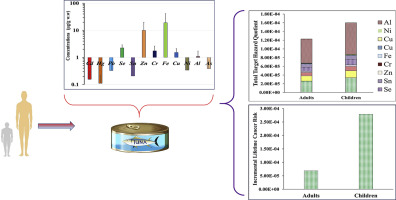Food and Chemical Toxicology ( IF 3.9 ) Pub Date : 2018-06-18 , DOI: 10.1016/j.fct.2018.06.023 Jamal Rahmani , Yadolah Fakhri , Abbas Shahsavani , Zohreh Bahmani , Mauricio A. Urbina , Salvatore Chirumbolo , Hassan Keramati , Bigard Moradi , Abotaleb Bay , Geir Bjørklund

|
Human consumption of fish protein, including canned tuna fish, is increasing steadily worldwide. However, there are some concerns about the potential exposure to elevated concentrations of metals in canned tuna fish. Several studies have been conducted in Iran regarding the concentration of metals in seafood, including copper (Cu), selenium (Se), iron (Fe), zinc (Zn), mercury (Hg), lead (Pb), chromium (Cr), arsenic (As), nickel (Ni), tin (Sn), and cadmium (Cd) in canned tuna fish. The main aim of this study was to gather data from existing papers and to perform a meta-analysis of the pooled concentrations of metals to evaluate their non-carcinogenic and carcinogenic risks in children and adults consumers. Search was conducted retrieving data from the international biomedical databases with highly public access and consultation, e.g., Web of Science, PubMed, Science Direct, and Scopus, and national database (SID and Irandoc) between 1983 and November of 2017. Data from 23 articles and 1295 samples were assessed and extracted. The ranking order of metals based on mean concentrations (μg/g wet weight) were Fe (13.17) > Zn (9.31) > Se (2.23) > Al (1.8) > Cr (1.63) > Cu (1.52) > As (0.38) > Ni (0.33) > Pb (0.24) > Cd (0.14) > Hg (0.11) > Sn (0.1). Except for Cd and Se, concentrations of other metals in the canned tuna fish were lower than the limits recommended by the United States Environmental Protection Agency (USEPA), World Health Organization (WHO), Food and Agriculture Organization (FAO) and Iran National Standards Organization (INSO). The minimum and maximum target hazard quotient (THQ) for adults were 5.55E-5 for Al and 2.23E-08 for Cr. For children, they were 7.23E-05 for Al and 2.91E-08 for Cr. THQ, and total target hazard quotient (TTHQ) were ≤1.0 for adult and children consumers. The Incremental Lifetime Cancer Risk (ILCR) of As was 3.21E-5 in adults and 4.18E-5 in children. Adults and children that consume canned tuna fish in Iran are not at non-carcinogenic risk but have a carcinogenic risk due to As.
中文翻译:

伊朗金枪鱼罐头中金属浓度的系统评价和荟萃分析以及人类健康风险评估
人类对鱼蛋白的消费,包括金枪鱼罐头,在世界范围内稳步增长。但是,人们对金枪鱼罐头鱼中可能会暴露于高浓度金属的潜在担忧。伊朗已就海鲜中金属的浓度进行了几项研究,其中包括铜(Cu),硒(Se),铁(Fe),锌(Zn),汞(Hg),铅(Pb),铬(Cr)金枪鱼罐头鱼中的砷,砷(As),镍(Ni),锡(Sn)和镉(Cd)。这项研究的主要目的是从现有论文中收集数据,并对汇总的金属浓度进行荟萃分析,以评估其对儿童和成人消费者的非致癌和致癌风险。通过高度公开的访问和咨询从国际生物医学数据库中检索数据,例如,1983年至2017年11月之间的Web of Science,PubMed,Science Direct和Scopus以及国家数据库(SID和Irandoc)。评估并提取了来自23篇文章和1295个样本的数据。基于平均浓度(μg/ g湿重)的金属排名顺序为Fe(13.17)> Zn(9.31)> Se(2.23)> Al(1.8)> Cr(1.63)> Cu(1.52)> As(0.38) )> Ni(0.33)> Pb(0.24)> Cd(0.14)> Hg(0.11)> Sn(0.1)。金枪鱼罐头中除镉和硒外,其他金属的浓度均低于美国环境保护局(USEPA),世界卫生组织(WHO),粮食及农业组织(FAO)和伊朗国家标准所建议的限量组织(INSO)。成人的最小和最大目标危险商(THQ)为Al为5.55E-5,Cr为2.23E-08。对于儿童,铝为7.23E-05,铬为2.91E-08。成人和儿童消费者的THQ和总目标危险商(TTHQ)≤1.0。砷的终生终生癌症增量(ILCR)为3.21E-5,儿童为4.18E-5。在伊朗,食用罐头金枪鱼的成年人和儿童没有非致癌风险,但由于砷而具有致癌风险。











































 京公网安备 11010802027423号
京公网安备 11010802027423号